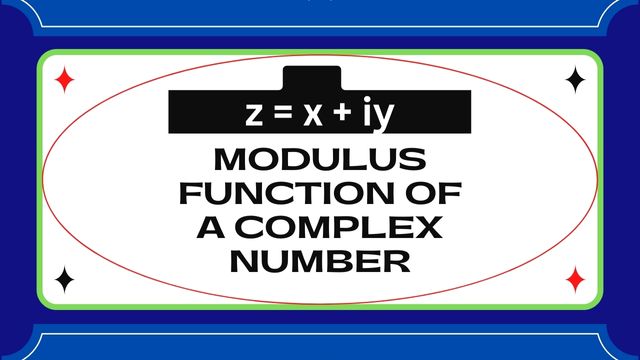Complex numbers have a modulus defined as their distance from the origin in the argand plane. A complex number (z = x + iy) which has x and y as real variables and i = 1 is called a modulus of a complex number (z = x + iy). Complex numbers are also called absolute numbers because of their modulus.
Our objective is to illuminate the algebraic and graphic representations of complex numbers along with their formula and examples for a better understanding of moduli. Modulus Function are those modulus gives the absolute value of a number or variable are known as modulus functions. A magnitude is produced based on the number of variables. In addition to being called an absolute value function, it is also called a value function. Regardless of the input, the outcome of this function is always positive.
What is the Modulus of a Complex Number?
Complex numbers have moduli equal to the square root of the sum of their real and imaginary parts. A complex number z has the modulus 1/2 of its real and imaginary parts, and it is denoted by Z by |z|. In the complex plane, the modulus of z = a + ib corresponds to the distance between the origin (0, 0) and the point (a, b). Complex numbers have a non-negative modulus because the distance is their modulus.
Modulus of Complex Number Formula
Modulus of a complex number z = x + iy, denoted by |z|, can be found by formula |z| = + (x2 + y2), where x is the real part and y is the imaginary part. By using the conjugate of a complex number z, one can calculate the modulus of the number.
Modulus of Complex Number Using Graph
Modulus of complex numbers is the distance between their coordinates on a complex plane and their origin on a graph. A complex number’s modulus is its distance from a point in the argand plane (a, b). The distance r between the origin (0, 0) and the point (a, b) is a linear distance expressed as r = (a2 + b2).
A complex number’s modulus can be derived from Pythagoras’ theorem, in which the hypotenuse represents the modulus, the real part represents the base, and the imaginary part represents the altitude. A complex number a + bi has a modulus that is equal to the magnitude (or length) of the vector that represents it.
Complex number modulus properties
A complex number has the following properties. The following is true if z and w are two complex numbers:
Complex numbers z and -z have the same modulus, that is, |z| = |-z|
Complex numbers have a modulus of 0 only if and only if they are zeros. That is, |z| = 0 if z = 0
In other words, |z.w| = |z|.|w| is the modulus of the product of complex numbers.
Quotients of two complex numbers have the same modulus as their quotients, i.e., |z/w| = |z|/|w|
Modulus of a complex number equals modulus of the conjugate of the complex number, i.e.,
|z|=|¯z|
A complex number’s modulus is its distance from the origin (0, 0) expressed as a point in the argand plane (a, b).
Complex numbers have a modulus of 0 if and only if they are zero.
As a complex number a + bi is represented by a vector, its modulus is its magnitude (or length).

